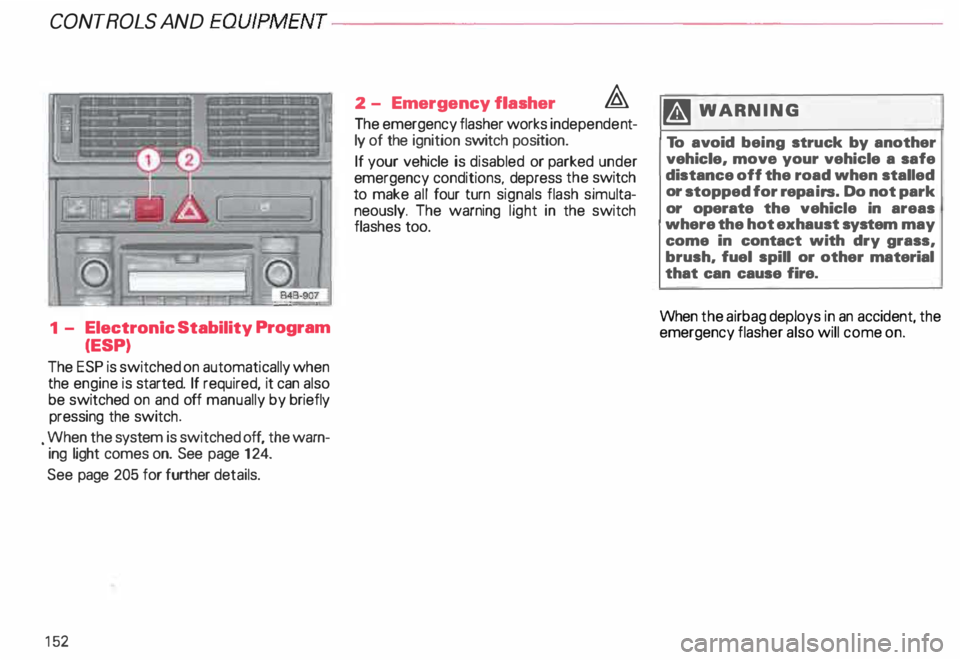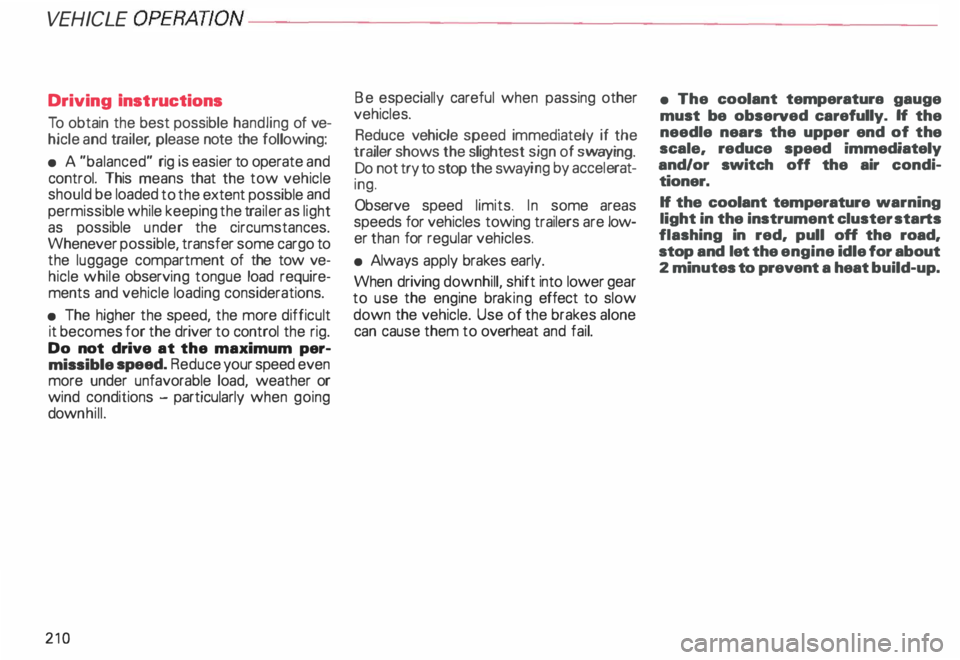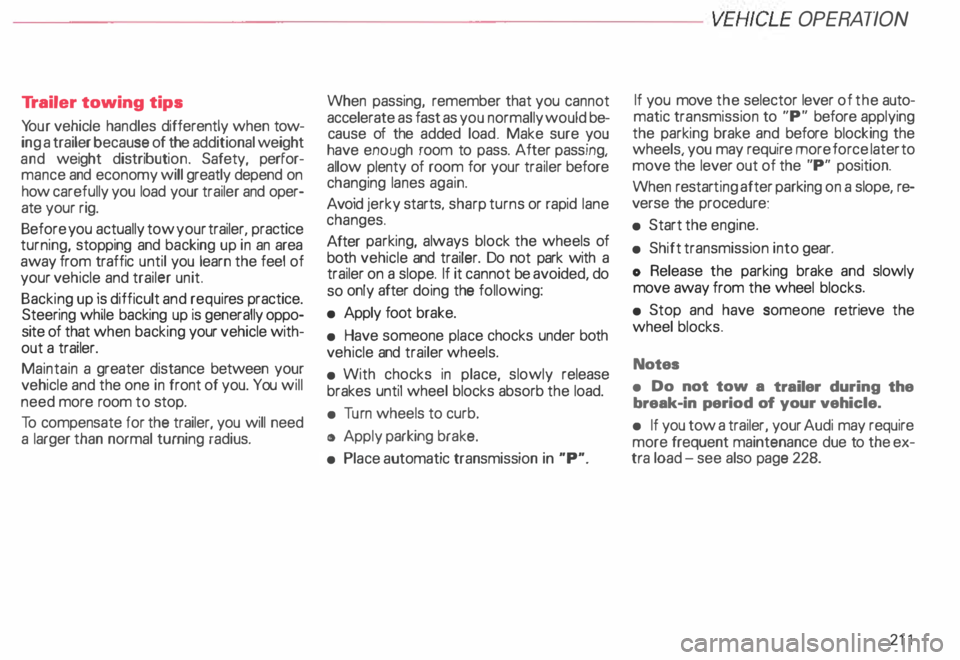2000 AUDI ALLROAD stop start
[x] Cancel search: stop startPage 153 of 306

CONTROLS AND EQUIPMENT---------------------
1
- Electronic Stability Program
(ESP)
The ESP is switched on automatically when
the engine is started. If required, it can also
be switched on and off manually by briefly
pressing the switch .
. When the system is switched off, the warn
ing light comes on. See page 124.
See page 205 for further details.
15 2 2
- Emergency flasher �
The emergency flasher works independe nt
ly of the ignition switch position.
If your vehicle is disabled or parked under
emergency conditions, depress the switch
to make all four turn signals flash simulta
neously. The warning light in the switch
flashes too. ftl
WARN ING
To avoid being struck by another
vehicle, move your vehicle a safe
distance off the road when stalled
or stopped for repairs. Do not park
or operate the vehicle in areas
where the hot exhaust system may
come in contact with dry grass,
brush, fuel spill or other material
that can cause fire.
When the airbag deploys in an accident, the
emergency flasher also will come on.
Page 196 of 306

------------------------VEHICLE
OPERATION
Operate your vehicle economically and
• Do not drive if you are tired.
Make frequent rest stops, at least after ev
ery two hours of driving.
• Always adapt vehicle speed to
traffic, weather and road condi
tions.
Remember that especially on smooth, slip
pery roads, vehicle handling and braking de
pend a great deal on tire adhesion. On wet
roads, the front wheels can hydroplane es
pecially at higher speeds. If this happens,
you will then, no longer be able to steer or
brake properly.
• Always observe the posted speed
limits and use common sense. Your
good judgment can mean the differ
ence between arriving safely at your
destination and having an accident.
Additional information regarding safety can
be found in the individual chapters of this
manual. minimize
pollution
Va rious factors influence fuel consumption:
engine wear, brakes and tires, environmen
tal impact.
This chapter addresses some of these
points.
Yo ur personal sty!e of driving
wi II determine the economy of your vehicle,
as well as exhaust and noise levels.
«i? Do not let your vehicle stand and
, warm
up.
When the engine is idling, it takes a very
long time to warm up. Moreover, during
warm-up, both engine wear and exhaust
gas emissions are very high. Therefore, be
ready to drive off immediately after starting
the engine and avoid high engine speeds.
«i? Avoid full throttle.
Accelerating gently reduces fuel consump
tion, engine wear, and does not disturb the
environment. <£'
Avoid driving at high speed.
Fuel consumption, exhaust emissions and
engine noise increase disproportionately at
high speeds. If you drive at approximately
three quarters of top speed, fuel consump
tion will be reduced by one half. Never drive
faster than the posted speed limit and
weather conditions permitting.
r.:Cib Drive as smoothly as possible
W5 and keep a lookout ahead.
Unn ecessary accelerating and braking in
crease fuel consumption and disturb the en
vironment.
r.:Cib Switch off your engine if you are
W5 caught in a traffic jam. This
saves fuel and reduces emissions.
195
Page 205 of 306

VE
HICL E OPERA TION-----------------------
'4 WARN ING continued
• Before descending a steep
grade, reduce speed and shift
transmission into a lower gear or
lower driving position. Do not ride
the brakes or hold the pedal down
too long or too often. This could
cause the brakes to get hot and di
minish braking efficiency.
• If you damage the front spoiler,
or if you install a different spoiler,
be sure the air flow to the front
brakes is not obstructed. Other
wise the brake system could over
heat reducing the effective ness of
the entire brake system.
• Failure of one brake circuit will
impair the braking capability re
sulting in an increased stopping
distance.
Avoid driving the vehicle and have
it towed to the nearest Audi Dealer
or qualified workshop.
204 Electronic differential lock
(EDL)
The EDL operates in conjunction with the
ABS. The EDL acts automatically, i.e. with
out the driver's intervention.
With the aid of the ABS sensors, this sy
stem monitors the speed of the driven
wheels up to about 50 mph, 80 km/h .
Within the speed range at which this sy
stem operates, if the wheels spin (e.g. on
slippery surfaces) they are braked in a con
trolled manner , and more of the engine's
power is directed to whiche ver wheels
achieve greater traction.
Please note:
• When driving off, always be sure to keep
road conditions in mind as you accelerate.
If a drive wheel spins because it's on a slip
perier surface, gradually increase the pres
sure on the accelerator pedal until the car
starts to move. •
When accelerating on slippery surfaces,
such as on ice or snow, always be careful
when depressing the accelerator pedal.
Even with the EDL working, the drive
wheels can spin and reduce your ability to
control your car.
• To prevent the disc brake of the braked
wheel from overheating, if subjected to ex
cessive loads the EDL cuts out temporarily.
The vehicle remains operational and be
haves in the same way as a vehicle without
EDL
If a fault occurs in the ABS the EDL is also
not functioning. This is ind icated by the ABS
warning light-see page 125.
ftl WARNING
The increased safety afforded by
EDL does not mean that you can
take safety risks. Always adapt
your driving style to the road con
ditions and traffic situation.
Page 211 of 306

VEHICLE OPER
ATION-----------------------
Driving Instructions
To obtain the best possible handling of ve
hicle and trailer , please note the following:
• A "balanced" rig is easier to operate and
control. This means that the tow vehicle
should be loaded to the extent possible and
permissible while keeping the trailer as light
as possible under the circumstances.
Whenever possible, transfer some cargo to
the luggage compartment of the tow ve
hicle while observing tongue load require
ments and vehicle loading considerations.
• The higher the speed, the more difficult
it becomes for the driver to control the rig.
Do not drive at the maximum per
missible speed. Reduce your speed even
more under unfavorable load, weather or
wind conditions - particularly when going
dow nhill.
210 Be
especially careful when passing other
vehicles.
Reduce vehicle speed immediately if the
trailer shows the slightest sign of swaying.
Do not try to stop the sway ing by accel erat
ing.
Observe speed limits. In some areas
speeds for vehicles towing trailers are low
er than for regular vehicles.
• Always apply brakes early.
When driving downhill, shift into lower gear
to use the engine braking effect to slow
down the vehicle. Use of the brakes alone
can cause them to overheat and fail. •
The coolant temperatura gauge
must be observed carefully. H the
needle nears the upper end of the
scale, reduce speed immediately
and/or switch off the air condi
tioner.
If the coolant temperature warning
light in the instrument cluster starts
flashing in red, pull off the road,
stop and let the engine idle for about
2 minutes to prevent a heat build-up.
Page 212 of 306

-----------------------VEHICL E OPER ATION
Tr ailer towing tips
Yo ur vehicle handles differently when tow
ing a trailer because of the additional weight
and weight distribution. Safety, perfor
mance and economy will greatly depend on
how carefully you load your trailer and oper
ate your rig.
Before you actually tow your trailer, practice
turning, stopping and backing up in an area
away from traffic until you learn the feel of
your vehicle and trailer unit.
Backing up is difficult and requir es practice.
Steering while backing up is generally oppo
site of that when backing your vehicle with
out a trailer.
Maintain a greater distance between your
vehicle and the one in front of you. You will
need more room to stop.
To compensate for the trailer, you will need
a larger than normal turning radius. When
passing, remember that you cannot
accelerate as fast as you normally would be
cause of the added load. Make sure you
have enough room to pass. After passing,
allow plenty of room for your trailer before
changing lanes again.
Avoid jerky starts, sharp turns or rapid lane
changes.
After parking, always block the wheels of
both vehicle and trailer. Do not park with a
trailer on a slope. If it cannot be avoided, do
so only after doing the following:
• Apply foot brake.
• Have someone place chocks under both
vehicle and trailer wheels.
• With chocks in place, slowly release
brakes until wheel blocks absorb the load.
• Turn wheels to curb.
o Apply parking brake.
• Place automatic transmission in "P". If
you move the selector lever of the auto
matic transmission to "P" before applying
the parking brake and before blocking the
wheels, you may require more force later to
move the lever out of the "P" position.
When restarting after parking on a slope, re
verse the procedure:
• Start the engine.
• Shift transmission into gear.
o Release the parking brake and slowly
move away from the wheel blocks.
• Stop and have someone retrieve the
wheel blocks.
Notes
• Do not tow a trailer during the
break-in period of your vehicle.
• If you tow a trailer, your Audi may require
more frequent maintenance due to the ex
tra load -see also page 228.
211
Page 303 of 306

ALP
HABETICAL INDEX
Safety belts ... ...... ... ... . _ . . 14
- Belt tensioner . . . . . . . . . . . 24
Safety compliance sticker . . . . . . 290
Seat belts and older children . . . . . 49
Seating capacity .... .. ... .. _.. . . 19
Seats ............ ... .. ..• .. , . 76
Secondary key . . . . . . •. _. • • . . 56
Securing a child seat . . . . . . . . . .
51
Securing luggage . . . . . . . . • . , . 89
Self-lev eling suspension . . • 123
Service interval display . . . . • • • . . 12 1
Service literature wallet .. .• .• .. 18 3
Service Repair Manuals . . • • 293
Setting a date . . . . . . . . . . . • • . . 135
Setting the menu ..... ... .. . _ . . 131
Setting the time I date . . . . . . 118
SID EGUARD . . . . . . .
. . . 39
•
Ski sack ........... •.••.••• ••.. 96
Sliding roof ........ _ ..• .. _ .... 168
Sliding I prop-up roof . . . . .• .. , . 168
Snow chains . . . . . • • • . .
261
Socket . .. . .. • . .. •
. • . . .. . .
181
Solar roof ...
Spare wheel
302 16
6, 170
. . 266 Spark
plugs .... _ ..... _ .. .. . _ . . 249
Speed range . . . . ..•.. . , 193
Speedometer . . . . . . . • . .
119
Starter switch . . . . . . . . . . . • . • . . 113
Starti ngmenu ..... ... ... ... .. 131
Starting procedures . . . . . .. , , 114
Starting with jumper cables ..... 278
Steering lock . . . . . . . . . . . , , • • • 113
Steering wheel .......... ••• .. _. 98
- Tiptronic . . . . . . . . . . . .
106
Steering wheel with Audio
controls . . . . . . . . . . . . . . . . . . . . 18 5
Stopping engine . . . . . . . . .
115
Storage compartmen t light . . . . . 178
Storage compartments . . . . . . . . . 182
Storing outside mirror setting . . . . 81
Storing seat position . . . . . . . . 81, 83
Storing steering wheel position . . 81
Sun shade . . . . . . . . . . . . . . . . . • . . 177
Sun visors . . . . . . . . . . . . . . . . . . 177
Sunr oof . . . . . . . . . . . . . . . . . • •.. 168
_Suspension, self-leveling . . . . . . . 123
Switches . . . . . .
148 Ta
chometer ••.. .• ••• ... •.
• . . 117
I • • • 57
286
... .. 190
Ta
g ......... ... ..... .. .
Tec hnical data ...•
Te lephone ..... .
Te mper ature gauge
Tie-down hooks ... ..
.. . 118
Tilt and telescopic steering wheel
Tiptronic ......... _ .. _ .. _ .. .. .
- steering wheel . . . . .•• . , ..
lire .
89
98
10 5
106
- Pressure . . . . . • • . . • . . 253
- Replacement .. _ . . . . . . 255,
259
- Rotation . . . .
254
- Specification • • . . . . •
256
-W ear ....... 254
lire qualit y grading information . . 258
Tires . . . . . . . . . . . . . .
252
Too ls . . . . . . . . . . . . . . . . . • . . • . • 264
Tow ing........... • ..... ... • 281
To wing anchor ages • • . . . . . 281
Tra iler towing . . . . . . •• .. , • . .• • 208
- Driving instructions __ ... ... . 210